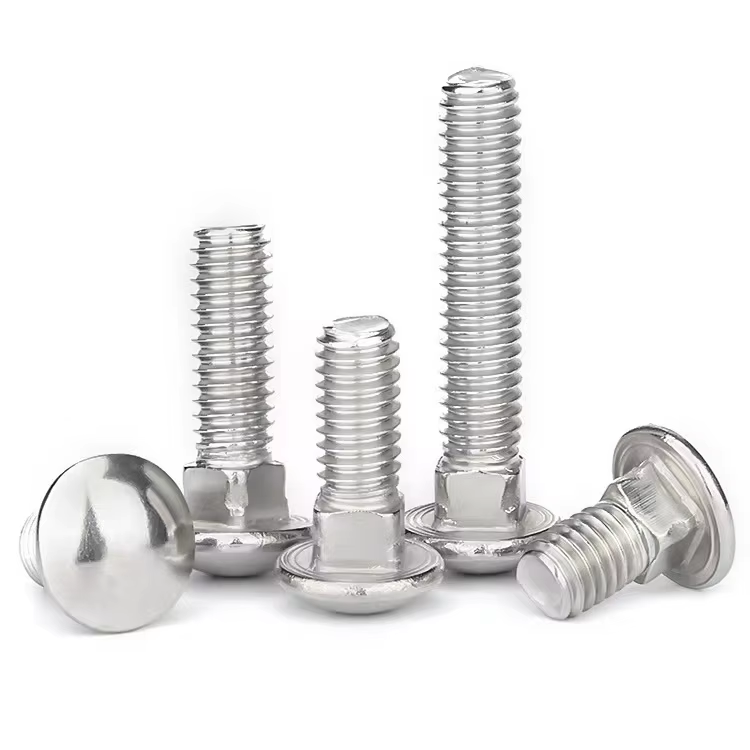Hex bolts are a type of fastener with a hexagonal-shaped head, commonly used in construction, automotive, and machinery applications. They feature a uniform diameter shaft with threads that help secure parts together, making them a key component in many mechanical and structural systems. Typically made of steel or other durable materials, these bolts are designed to withstand high stress and offer a secure hold.
When selecting hex bolts, precise measurements are critical to ensure the bolt fits perfectly and performs as expected. Incorrect measurements can lead to weak connections, causing safety risks, premature wear, or even failure of the whole structure or machine. Therefore, understanding how to measure hex bolts accurately ensures that the right size is chosen for any specific application.
Key Dimensions for Measuring Hex Bolts
Bolt Diameter
What is the Diameter of a Hex Bolt?
The bolt diameter is one of the most crucial dimensions. It refers to the width of the bolt shaft, typically measured across the threads. The diameter dictates how the bolt interacts with the hole it’s intended to fit into or the nut it’s supposed to thread into.
How to Measure the Diameter
To measure the diameter accurately, use a caliper or micrometer to measure the bolt across the outer edges of the threads. For standard hex bolts, the diameter is usually specified in either millimeters (metric system) or inches (imperial system).
Why Bolt Diameter Matters
A bolt that is too thick or too thin will not fit into its corresponding hole or nut. For instance, if the diameter is too large, the bolt may not pass through the hole, while a diameter that’s too small can result in a loose fit, leading to potential joint failure. Hence, ensuring the correct diameter guarantees that the bolt will securely fasten the components.

Bolt Length
How Is the Length of a Hex Bolt Measured?
The length of a hex bolt is measured from the underside of the head (the flat surface directly under the hexagonal head) to the tip of the threaded end. It is important to note that bolt length does not include the head, but rather just the shank (the portion that is threaded).
Why Bolt Length is Important
The correct bolt length is essential for ensuring the fastener reaches the necessary depth into the receiving hole and can be adequately secured by a nut. If the bolt is too long, it might protrude unnecessarily; if it's too short, it may not reach far enough to provide a secure fastening.
Common Length Increments
Hex bolts come in a wide range of lengths, typically in increments of 1/8” or 1mm, depending on whether the metric or imperial system is being used. It is critical to select a bolt with the appropriate length based on the specific needs of the project to avoid any potential issues.
Thread Pitch
What is Thread Pitch?
Thread pitch refers to the distance between threads along the length of the bolt. It determines how tightly the nut will fit onto the bolt. Thread pitch can either be fine or coarse, depending on the application. Fine threads are ideal for precision machinery, while coarse threads are better for larger, heavy-duty projects.
How to Measure Thread Pitch
To measure the thread pitch, use a thread gauge or caliper to measure the number of threads within a given distance (often one inch or one millimeter). If you're unsure whether the bolt is fine or coarse, check the manufacturer's specifications or use a thread pitch gauge to get an accurate reading.
Why Thread Pitch Matters
The wrong thread pitch can prevent the bolt from properly engaging with the nut or hole, leading to instability or even failure of the fastened joint. It is also important because fine threads provide better resistance to wear, while coarse threads are more resilient to stripping and easier to install.
Bolt Head Height
What is Head Height, and Why Does it Matter?
Head height refers to the thickness of the hexagonal bolt’s head, which plays a significant role in the bolt’s ability to be gripped and turned with a wrench or socket. Accurate measurement of the head height ensures that the bolt will fit into tight spaces and can be properly engaged during installation.
Why Head Height is Important
A bolt with an incorrect head height may not fit in the required space, making installation difficult or impossible. It also impacts the torque that can be applied during tightening. For example, a bolt with too small of a head may not provide sufficient grip for the tool, making it harder to tighten securely.
Bolt Grade and Strength
How Are Hex Bolt Grades Measured?
Bolt grades are a numerical system that defines the strength and material properties of a bolt. Common bolt grades include Grade 2, Grade 5, and Grade 8, each with different levels of tensile strength and performance characteristics. The higher the grade, the stronger the bolt.
Why Bolt Grade Matters
The grade of a hex bolt impacts its ability to withstand force, pressure, and wear. For example, Grade 2 bolts are suitable for light-duty applications, while Grade 8 bolts are intended for heavy-duty or high-stress applications. Knowing the correct grade ensures that you choose a bolt that can handle the forces at play in your project.
Standard Measurement Systems for Hex Bolts
Metric vs. Imperial Measurement Systems
What Are the Differences Between Metric and Imperial Systems?
Hex bolts can be measured in either the metric or imperial system. The metric system uses millimeters (mm) for both diameter and length, while the imperial system uses inches. The difference in units can sometimes cause confusion, especially when choosing bolts for international projects.
How to Convert Between Metric and Imperial Measurements
To convert from metric to imperial, divide the millimeter measurement by 25.4 to get the inch equivalent. For example, a bolt with a 10mm diameter would be approximately 0.394 inches. Understanding how to convert between these units is essential when sourcing bolts from different regions.
Why It Matters
Projects may require bolts that conform to specific standards based on their location, which is why it's essential to know which system to use for your specific application.
International Standards for Hex Bolts
What Are the Standard Measurements for Hex Bolts?
International standards, such as DIN, ISO, and ANSI, define the dimensional specifications for hex bolts to ensure uniformity across industries. These standards determine everything from the bolt’s head shape to its thread pitch, grade, and length. Adhering to these standards ensures that bolts are compatible across different countries and manufacturers.
Why Standards Matter
By using standardized hex bolts, you ensure that the fasteners are reliable, compatible, and readily available for various applications. It reduces the risk of mismatched parts and guarantees that bolts meet safety and performance criteria.
Tools for Measuring Hex Bolts
Calipers and Micrometers
How Do You Measure Hex Bolts with Calipers or Micrometers?
To measure the diameter and length of a hex bolt, calipers or micrometers are commonly used. Simply place the bolt into the tool, and adjust the jaws to measure the diameter across the threads. For length, measure from the underside of the bolt head to the tip of the threaded shaft.
Tips for Accurate Measurement
Ensure that the tool is calibrated, and that the bolt is measured at its widest point. For thread pitch, use a micrometer to measure the distance between threads, or a thread gauge for greater precision.
Thread Gauges
What is a Thread Gauge, and How Is It Used to Measure Thread Pitch?
A thread gauge is a tool used to measure the pitch of the threads on a hex bolt. To use a thread gauge, match the gauge’s teeth to the threads of the bolt. If the teeth fit perfectly, the gauge indicates the correct pitch.
Bolt Measuring Jigs
How Do Bolt Measuring Jigs Help with Accurate Measurements?
Bolt measuring jigs are designed to hold a bolt in place for precise measurement. By using a jig, you can quickly measure the critical dimensions of bolts without the risk of shifting or error.
Common Mistakes in Measuring Hex Bolts
Incorrect Measurement of Thread Pitch
How Can Incorrect Thread Pitch Measurements Affect Performance?
If the thread pitch is incorrectly measured, it can cause poor engagement with nuts, leading to loose fastenings or bolt failure. Always double-check thread pitch using a gauge to ensure compatibility.
Misunderstanding Length and Diameter
Why is It Important to Measure Both Length and Diameter Accurately?
Incorrect measurements of length or diameter can lead to bolts that don’t fit or function properly. It’s essential to match both measurements to the requirements of the project to ensure the correct fit and a strong, secure fastening.
Overlooking Bolt Grade and Material
How Does Neglecting Bolt Grade and Material Impact Strength?
Choosing the wrong bolt grade or material can lead to a failure to handle the required stress. Always match the grade and material of the bolt to the specifications of the project for maximum durability and strength.
How to Choose the Right Hex Bolt Based on Measurements
Matching Hex Bolt Measurements to Project Requirements
How Do You Choose the Right Hex Bolt?
By considering diameter, length, thread pitch, and grade, you can select the most appropriate hex bolt for your project. Make sure to evaluate the load requirements, environmental factors, and material types to choose the correct bolt.
Common Mistakes to Avoid When Choosing a Hex Bolt
What Are the Common Mistakes People Make?
Avoid mistakes like mismatching bolt sizes, selecting the wrong thread type, or using inappropriate grades. Understanding the requirements of your project ensures that you select the right bolt and avoid costly mistakes.

Conclusion
Recap of How Hex Bolts Are Measured
In summary, measuring hex bolts accurately involves determining their diameter, length, thread pitch, head height, and grade. These dimensions must be carefully checked to ensure that the selected bolt will fit correctly and perform reliably.
Final Thoughts: Importance of Proper Measurement
Proper measurement is critical to the success of any project involving hex bolts. Whether you're building a machine, constructing a building, or repairing a vehicle, ensuring you have the correct bolt for the job can prevent failures and increase safety.
FAQ
Q: How do I measure the diameter of a hex bolt?
A: Use calipers or a micrometer to measure across the outer edges of the threads.
Q: What is the difference between fine and coarse thread pitch?
A: Fine threads have a smaller distance between threads, while coarse threads are more durable.
Q: How do I measure the length of a hex bolt?
A: Measure from the underside of the head to the tip of the threaded end.
Q: What is a bolt grade, and why does it matter?
A: Bolt grade indicates strength and material properties, important for selecting the right bolt.
Q: How do I convert between metric and imperial bolt measurements?
A: Divide millimeter measurements by 25.4 to convert to inches.





































